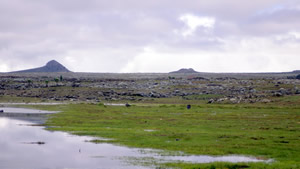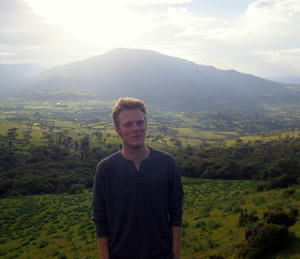August 30, 2014
By Steve Chignell
 This summer I had the opportunity to be part of a team from CSU led by Paul Evangelista (Natural Resource Ecology Laboratory) to conduct research in Ethiopia. This was my first trip to east Africa, which I had been studying and reading about for the past year. We spent the first two weeks meeting with colleagues and conducting research in various parts of the country, and the final week camping in the southern highlands of the Bale-Arsi massif, just to the east of the Rift Valley.
This summer I had the opportunity to be part of a team from CSU led by Paul Evangelista (Natural Resource Ecology Laboratory) to conduct research in Ethiopia. This was my first trip to east Africa, which I had been studying and reading about for the past year. We spent the first two weeks meeting with colleagues and conducting research in various parts of the country, and the final week camping in the southern highlands of the Bale-Arsi massif, just to the east of the Rift Valley.
An internationally recognized biodiversity hotspot and site of Bale Mountains National Park, Bale has one of the highest concentrations of endemic plants and animals in the world, and is known to be the origin of wild coffee. The area is also the source of five major rivers that are fed by large amount of orographic rainfall and flow out of the mountains and across the arid lowlands to the east. Along with providing critical wetland habitat for wildlife, these rivers are the only perennial source of water for about 12 million people living in Ethiopia, Somalia, and northern Kenya. They have their headwaters in the highest portions of the massif known as the Sanetti Plateau; a plane of glaciated volcanic rock with an average elevation of 4,000 m (13,123 ft). Approximately 1,000 km2 in size, the plateau comprises the largest afro-alpine area in Africa, and has characteristics distinct even from the rest of Bale.
During a week of fieldwork and camping in the nearby afro-montane forest, I had the opportunity to go up to the plateau for a day trip. I was particularly interested in the headwater hydrology of Sanetti and its wetlands which—although known to be critical for slowly releasing water throughout the dry season—have had few studies focused on their extent and seasonal dynamics.
As we drove up the escarpment, the landscape began to transition from lush forest and agriculture to alpine shrubland dotted with flowers and trees unlike anything I’d ever seen. We made our way past cliffs that descended hundreds of feet into clouded valleys teeming with vegetation and wildlife. Eventually, the road became level, and we were able to see the expanse of the plateau. Even though I was expecting it, I was still struck by the experience of arriving at the top of a mountain and seeing an enormous flat plane (a far cry from the Colorado Rockies). We only had to drive a little further before seeing wildlife. All kinds of birds, some endemic to the region and others from as far as South Africa flew overhead and bathed in nearby ponds. We watched as a male and female pair of Ethiopian wolves—found only here and in the Semien Mountains to the northwest—rolled and played with each other in the grass, then went hunting for giant mole rats that ventured too far from their tunnels.
We only had to drive a little further before seeing wildlife. All kinds of birds, some endemic to the region and others from as far as South Africa flew overhead and bathed in nearby ponds. We watched as a male and female pair of Ethiopian wolves—found only here and in the Semien Mountains to the northwest—rolled and played with each other in the grass, then went hunting for giant mole rats that ventured too far from their tunnels.
As we left the truck and began hiking, I saw countless, tiny headwater streams that trickled their way across the plateau, joining with others as they flowed toward the escarpment, or disappearing into holes in the volcanic rock. I watched as others flowed into the lakes and wetlands that dotted the landscape wherever we walked. Many of these waterbodies were less than a meter deep—formed in depressions left by the same glaciers that scraped their way across the plateau as recent as 2000 years ago. It was an incredible feeling to be there at the actual source of a number of major transnational rivers. To stand and watch the water literally bubble into the porous volcanic rock and think about it traversing the maps I’d been pouring over for the last year was an amazing experience. I thought about how some of this water would end up a thousand miles away to be used for irrigation in the dessert, or reappear as mineral springs that the local people had been using to water their animals for hundreds—if not thousands—of years. I watched as herds of cattle grazed at 13,000 ft, and thought about they fit into these natural systems.
Although I marked a number of these areas with my GPS and took copious amounts of notes from conversations with our guide, in hindsight I think that any data I collected that day was overshadowed by the experience of just being there. Exploring the plateau—if only for a few hours—brought so much of what I’d learned from studying journal articles and Google Earth together in a new way, and the experience has since enabled me to focus my research while simultaneously bringing up questions and ideas I never would have considered.
Exploring the plateau—if only for a few hours—brought so much of what I’d learned from studying journal articles and Google Earth together in a new way, and the experience has since enabled me to focus my research while simultaneously bringing up questions and ideas I never would have considered.
Since the trip in May, I have worked with a team to combine the data and experience gained on Sanetti with NASA satellite imagery, in order to generate the first comprehensive maps of Sanetti’s perennial lakes and wetlands. Our preliminary results identified over 20 lakes and 40 major vegetated wetlands that persist on the plateau throughout the dry season. We are currently working to acquire funding for a trip in early 2015 in order to validate our results via field sampling and participatory mapping sessions with local villages. My hope is that the maps and methods we generate will be useful tools for local land managers, as they work to address increasing pressures from rising populations and a changing climate. Ethiopia is an incredible landscape, with some of the kindest people and amazing cultures I have ever experienced. This trip has had significant influence on my graduate research, and has reinforced how grateful I am to work with people who have such a commitment—not only to field-based learning—but also to truly collaborative and applied science.
This trip was supported by the generosity of the NREL James E. Ellis Humans & the Environment Scholarship, as well as a travel award from the Colorado State University Office of International Development Studies. Thank you!!
Steve Chignell is a MS student studying Watershed Science in the department of Ecosystem Science and Sustainability, under Melinda Laituri.